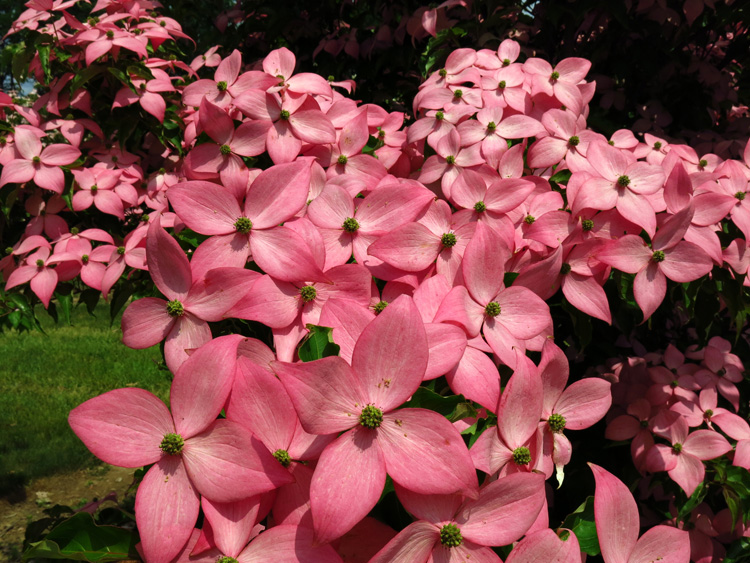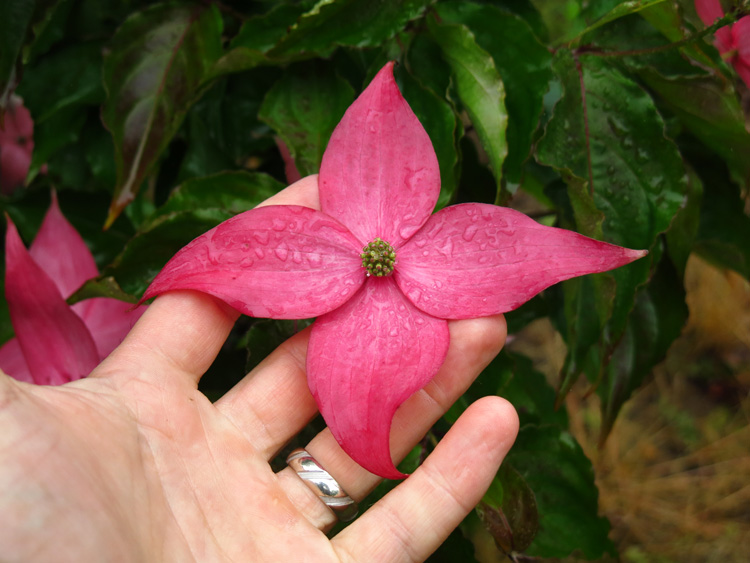‘Scarlet Fire’ Kousa Dogwood A Plant Breeding Breakthrough
Posted on: January 25, 2018 | Written By: Doug Oster |
I bumped into an old friend on the exhibit floor at the Mid Atlantic Nursery Trade Show in Baltimore and, as we exchanged pleasantries, he recognized renowned plant breeder Thomas Molnar, which stopped him in mid-sentence.
“You’ve got to meet him,” my friend said excitedly. “He’s doing amazing things at Rutgers.”
He led me over and introduced me to the 40-year-old associate professor at the New Jersey university. He actually has two fascinating breeding programs in progress. The first is the continuation of 40 years of breeding on dogwoods by Dr. Elwin Orton.

‘Scarlet Fire’ is a new kousa dogwood introduction bred by Thomas Molnar of Rutgers University.
“I picked up on his work. What he was trying to do was get a kousa dogwood that had very dark pink (flowers),” Molnar says of his mentor while sitting at a table in the middle of the convention center hall. “This is the first year for the release of ‘Scarlet Fire,’ which sports spectacular blooms of deep pink, almost rose colored blooms.
“Dr. Orton left me a lot of really interesting plants, a lot of light pink kousas,” he said, “He wasn’t able to sort of crack the code to get dark pink.”
Molnar carried on with the work, but instead of continuing to cross light pink cultivars, he decided to try something else. He planted five acres with thousands of seedlings from seeds collected from 50 different cultivars Orton had developed. The first round of plantings didn’t produce anything special, but Molnar continued planting over the next couple years.
“It wasn’t until about six years after I started the project this one plant bloomed, and it blew us away,” he said with a smile. “It was literally fuchsia pink.”

‘Scarlet Fire’ is a new kousa dogwood introduction bred by Thomas Molnar of Rutgers University.
Even though the colorful blooms are referred to as flowers, technically they are actually bracts. Molnar was thrilled to show off the new plant to his mentor and set up a meeting. Somehow the pair crossed wires and while Orton walked through fields he’d never planted in before, he discovered the plant on his own.
“He didn’t want to see anything else I was working on. ‘This is the plant,’ Orton said. ‘This is incredible.’ That was validation that this was really special,” Molnar said proudly.
The breeding team observed “Scarlet Fire” one more year before revealing it to Tennessee’s Hidden Hollow Nursery, which propagates dogwoods. The tree is hardy to zone 5 and can grow into zone 8.
“This new dogwood which built on Dr. Orton’s work, they’ve wanted this Kousa for decades,” Molnar says. “It’s just luck to come at the right time.”

Dr. Thomas Molnar, Associate Professor at Rutgers University holds hazelnuts.
Molnar has a passion project, too. He’s found a way to breed a hazelnut tree that’s resistant to eastern filbert blight. The tree has struggled in the east due to disease problems. He began with another mentor, the late Dr. Reed Funk, in 1996. “The target was, can we find resistant plants?” he says.
After finding disease-resistant varieties, they were crossed with other cultivars and, in 20 years time, have created a tree that will succeed in the mid-Atlantic region. His team is propagating the tree now that he knows this will be something important for growers. “It’s a whole new crop for farmers,” he says. “It’s a really low input crop, very few pest problems and you need almost no chemical sprays on the trees.”
It grows about the same size as a peach tree, but it doesn’t need much irrigation and the crop can be picked by machine as the nuts fall off the tree when they are ripe. “It’s exciting, we’re not there yet,” he says. “We’re still testing them, we’re right on the edge.”
He’s got farms ready to take trees and see how they do.
Restaurants, candy makers, bakers and lots of others long for fresh, locally grown hazelnuts. It’s rare to bring a new crop to an area and he thinks the tree is a game-changer for the food industry.
Molnar hopes that what he’s created will become his legacy. “It gives you something that lives beyond,” he says of the trees. “When I’m gone, those plants can live on forever.”
Doug Oster is editor of Everybody Gardens, a website operated by 535Media, LLC. Reach him at 412-965-3278 or doster@535mediallc.com. See other stories, videos, blogs, tips and more at everybodygardens.com.
Note: Here’s a video Molnar shot of the tree.